The number 30 play in our countdown to determine the best plays of Tennessee’s 2015 season is Josh Dobbs’ touchdown run on the Speed Option against Missouri.
PLAY #30 – Josh Dobbs and the Speed Option
To say that the Vols 19-8 win over the Missouri Tigers was a game of defense would be an understatement. The Tigers were held scoreless through three quarters, and the Vols only managed to score a single touchdown. That touchdown came on a fantastic play by quarterback Josh Dobbs.
With only 23 seconds remaining in the first half, Tennessee faced a third-and-four at the Missouri nine yard line. Offensive coordinator Mike DeBord dialed up a quick passing play, designed for Dobbs to get the ball to slot receiver Von Pearson in the left flat.
When Dobbs got in position, he noticed a weakness in the defense. The Tigers only had five players lined up to Dobbs’ left.
Based on Missouri’s alignment, Dobbs identified that the defensive end was the force defender. This means that the end is responsible for outside contain; he cannot get beat outside. He is the last line of defense on the edge, so he must “force” the ball back inside to his teammates. There will be no linebacker or safety coming down on the edge to help with outside containment. All of his help is inside, so he can not allow the ball to get outside of him.
Dobbs identified that the Vols had just the look they wanted to run another play: the Speed Option. Once Dobbs recognized the look the defense was in, he rushed to the line of scrimmage and instructed his line to block for the Speed Option. Dobbs then told Jalen Hurd the new play call.
The Speed Option is blocked using Outside Zone rules. The Vols’ offensive linemen will all take a wide, lateral step to the playside, and attempt to reach block the defender across from them. There is one difference between the base Outside Zone blocking scheme and the Speed Option. The playside offensive tackle, left tackle Kyler Kerbyson on this play, will bypass the defensive end and block the next defender.
This playside end is the read player. The quarterback will take the snap and run right at the read defender. Dobbs must attack the read defender, keeping his eyes on him all the way. Dobbs must force him to make a decision - commit to the quarterback or commit to the back, who is running wide. If the defender squeezes inside to tackle Dobbs, then the quarterback will pitch the ball to the Hurd on the edge. If the end steps outside to contain Hurd, then Dobbs will keep the ball inside.
The Speed Option is not a part of the Vols base offense. Mike DeBord rarely, if ever, calls the play from the sideline. Instead, this is a play that Dobbs will audible to when he sees a specific look from the defense.
The best way to defend the Speed Option is to have the defensive end squeeze inside to take the quarterback, with a safety or outside linebacker coming down to tackle the running back. This makes the safety/outside linebacker the force defender. The end can afford to take away the inside option, because he is not the force defender. He knows he has help outside.
Based on the alignment of the Tigers, defending the option this way is impossible. The only safety is lined up over the middle of the field, unable to defend the edge, and the strongside linebacker is clearly playing man coverage against Pearson in the slot. The end is obviously the force defender, and the only defender in position to stop the option. This means the Vols will have a two-on-one advantage (Dobbs and Hurd versus the end).

The RED defender is the unblocked read defender.
As soon as he saw this alignment, Dobbs rushed to the line to change the play. Rather than throw a quick pass versus tight man coverage, Dobbs knew he could have success on the Speed Option.
So now, back to the play itself. The read player, defensive end Charles Harris, quickly recognized the play, and stepped outside to defend Hurd.
Harris makes the correct decision. He is the force defender and must keep the ball inside. Should Dobbs get the pitch off to Hurd, the running back will easily be able to walk in the end zone. If Harris can force Dobbs to cut back inside, one of his teammates may be able to make the stop.
Harris (#91) is able to get in between Dobbs and Hurd, making sure that Dobbs has to keep the ball inside.
Harris actually does a phenomenal job here. He is able to get outside of Dobbs, blocking his pitch lane and taking Hurd out of the play. Harris is then able to even get his hands on Dobbs, making an attempt at an arm tackle.
This is where the Vols’ quarterback simply takes over. Dobbs made one of his best plays of the season, running through a tackle attempt of no less than five defenders on his way to the end zone. This is just an outstanding individual play.
This play is a great example of Dobbs’ importance to the team. He recognized the defense was in a look that left them vulnerable to the Speed Option, audibled to the correct play, and then powered the ball into the end zone on an outstanding individual effort.
You can read previous installments of this series by clicking below:
Play #35 - Evan Berry’s Pick Six
Play #34 - Preston Williams’ First Touchdown
Play #33 - LaDarrell McNeil’s Comeback
